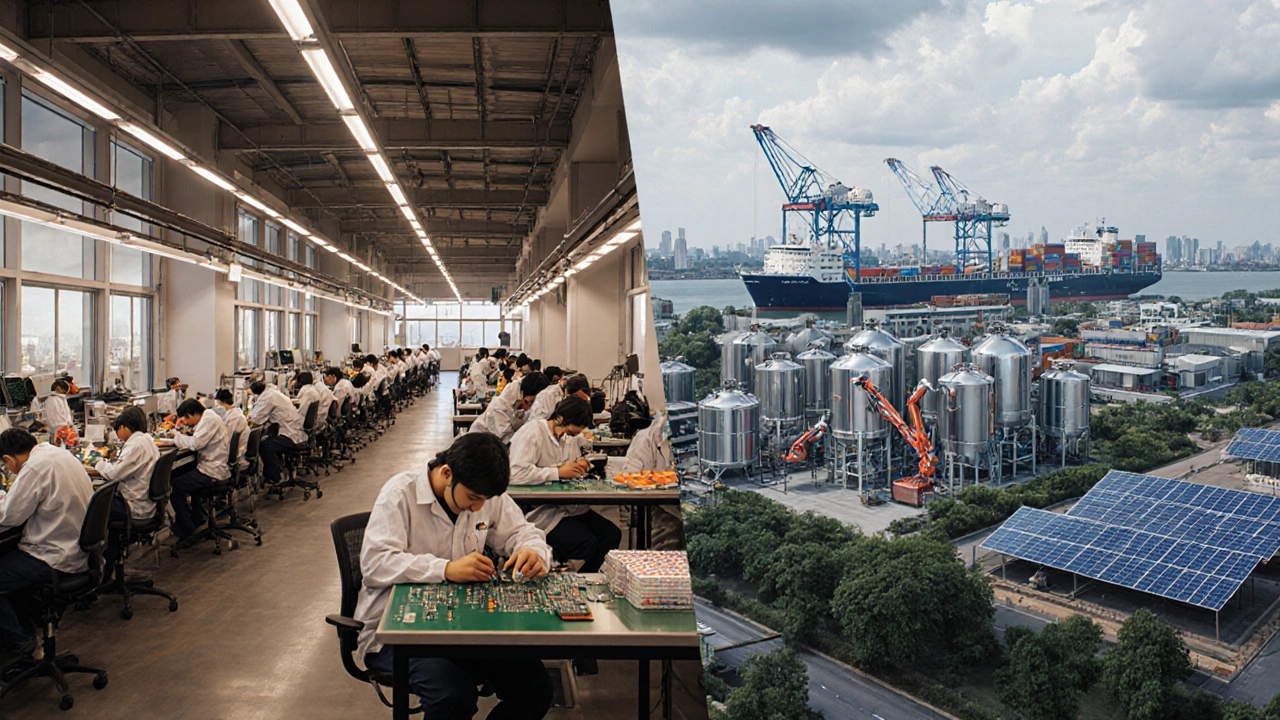Manufacturing Hub Decision Tool
Your Manufacturing Needs
Comparison Results
Recommended Hub
Hub Comparison
China
Manufacturing GDP: $4.8T
Vietnam
Manufacturing GDP: $0.5T
India
Manufacturing GDP: $0.8T
Germany
Manufacturing GDP: $1.3T
United States
Manufacturing GDP: $2.2T
Mexico
Manufacturing GDP: $0.4T
Quick Takeaways
- The current manufacturing capital of the world is a shifting title, with China still leading but Vietnam and India gaining fast.
- Government schemes like Make in India and Made in China 2025 are major drivers of the shift.
- Key metrics to watch: total manufacturing output, export share, labor cost, and policy support.
- For businesses, the next‑best hubs after China are Vietnam for electronics and India for automotive & pharma.
- Understanding each hub’s strengths helps you decide where to locate new factories or supply‑chain partners.
When we talk about a "manufacturing capital," we mean the city, region, or country that produces the largest share of the world’s manufactured goods while also shaping global supply chains. Manufacturing capital is a benchmark that combines output volume, export value, innovation capacity, and policy environment into a single ranking. In 2025 the title isn’t held by a single place; it’s a contest between a handful of powerhouses, each backed by aggressive government programs.
Why China still dominates
China is the world’s biggest manufacturer, accounting for roughly 30% of global industrial output. Its scale comes from massive investment in infrastructure, a deep supplier ecosystem, and the long‑running Made in China 2025 plan, which pushes high‑tech sectors like robotics, AI‑driven factories, and electric vehicles.
Key figures (2024):
- Manufacturing GDP: US$4.8 trillion
- Export value: US$2.6 trillion
- Average labor cost: US$7.5 hour⁻¹
The policy focus on automation keeps productivity high, even as wages rise.
Emerging challengers: Vietnam and India
Vietnam has become the go‑to destination for electronics assembly. Friendly tax regimes, a young workforce, and proximity to major sea routes let it capture 10% of global electronics output, up from 4% in 2018.
Meanwhile, India is leveraging its massive domestic market and the Make in India initiative to grow automotive, pharma, and textiles manufacturing. Export‑oriented sectors have risen 12% YoY, and labor costs remain under US$2 hour⁻¹.
Both countries benefit from government subsidies, streamlined land‑allocation processes, and growing skill‑development programs.
Traditional European power: Germany
Germany remains Europe’s manufacturing beacon, especially in high‑precision machinery, automotive engineering, and chemicals. Its strength lies in a skilled workforce, strong R&D tax credits, and the EU’s Horizon Europe research funding.
Key stats (2024):
- Manufacturing GDP: US$1.3 trillion
- Export value: US$900 billion
- Labor cost: US$35 hour⁻¹
While labor is pricey, high value‑added output offsets the cost.

North America’s role: United States and Mexico
The United States still leads in advanced manufacturing, AI‑driven automation, and aerospace. The 2022 Inflation Reduction Act added tax credits for reshoring clean‑energy equipment, spurring a modest rebound in domestic production.
Mexico benefits from the Maquiladora program, which offers duty‑free import of components for assembly and re‑export. Low labor costs (US$3 hour⁻¹) and proximity to the U.S. market make it a key hub for automotive and electronics.
How to compare the top hubs
| Hub | Manufacturing GDP (US$ trillion) | Export Share (%) | Average Labor Cost (US$/hour) | Major Govt Scheme |
|---|---|---|---|---|
| China | 4.8 | 30 | 7.5 | Made in China 2025 |
| Vietnam | 0.5 | 10 | 2.3 | Electronics Incentive Package |
| India | 0.8 | 8 | 1.9 | Make in India |
| Germany | 1.3 | 12 | 35 | Horizon Europe |
| United States | 2.2 | 18 | 30 | Inflation Reduction Act |
| Mexico | 0.4 | 9 | 3.0 | Maquiladora Program |
Practical steps for businesses deciding where to locate
- Identify the product tier: high‑value, low‑volume (e.g., aerospace) or low‑value, high‑volume (e.g., consumer electronics).
- Match the tier to a hub’s strength: Germany for precision engineering, Vietnam for cheap electronics, India for pharma.
- Check the local incentive landscape: tax breaks, subsidies, and training grants. For instance, Vietnam’s Electronics Incentive Package offers up to 10% tax reduction on first‑year profits.
- Factor in logistics costs: sea‑port proximity, rail links, and customs procedures. Mexico’s NAFTA‑derived corridor to the U.S. Midwest is a major advantage.
- Run a scenario analysis: compare total landed cost, lead‑time risk, and regulatory compliance across at least three hubs before committing.

Common pitfalls and how to avoid them
- Assuming low labor cost means low total cost - ignore energy, compliance, and transportation.
- Overlooking policy volatility - government schemes can be reshaped after elections; always add a contingency clause.
- Neglecting talent pipelines - invest in local training programs early to secure skilled workers.
Future outlook: who could overtake the current leaders?
By 2030, three trends could reshape the map:
- Automation diffusion making labor cost less decisive.
- Green manufacturing policies in the EU and United States driving investment toward low‑carbon hubs.
- South‑East Asian countries (e.g., Thailand, Indonesia) expanding special economic zones with heavy subsidies.
Watch for the next wave of government schemes aimed at AI‑driven factories - they’ll be the decisive factor for the next manufacturing capital.
Frequently Asked Questions
Which country produces the most manufactured goods?
China remains the top producer, accounting for roughly 30% of global manufacturing output in 2024.
What are the biggest government schemes supporting manufacturing today?
Key programs include China’s Made in China 2025, India’s Make in India, the United States’ Inflation Reduction Act, the EU’s Horizon Europe, and Mexico’s Maquiladora program.
Why is Vietnam gaining market share in electronics?
Vietnam offers low labor costs, a favorable tax environment, and a stable political climate, attracting major OEMs like Samsung and Apple’s suppliers.
How does Make in India help foreign manufacturers?
The initiative provides fiscal incentives, fast‑track approvals, and investment subsidies for sectors such as automotive, pharma, and renewable energy equipment.
Is it still worth building factories in the United States?
Yes, especially for high‑tech, aerospace, and clean‑energy products where government tax credits and advanced supply chains offset higher labor costs.
